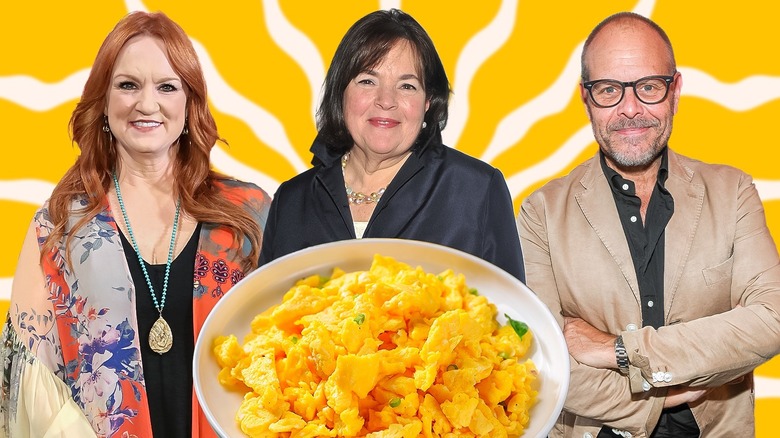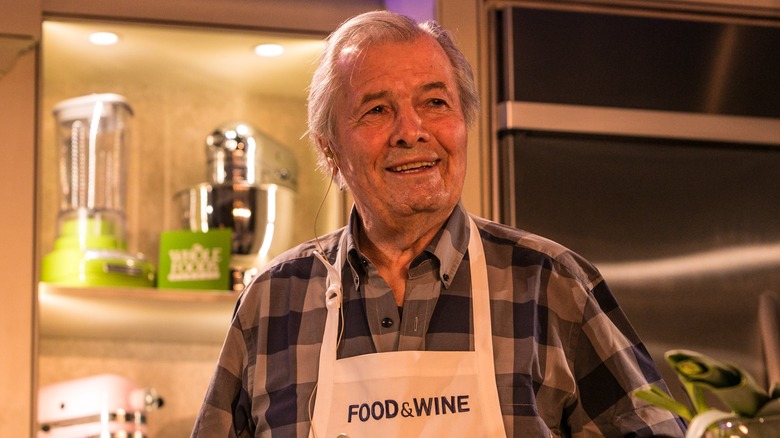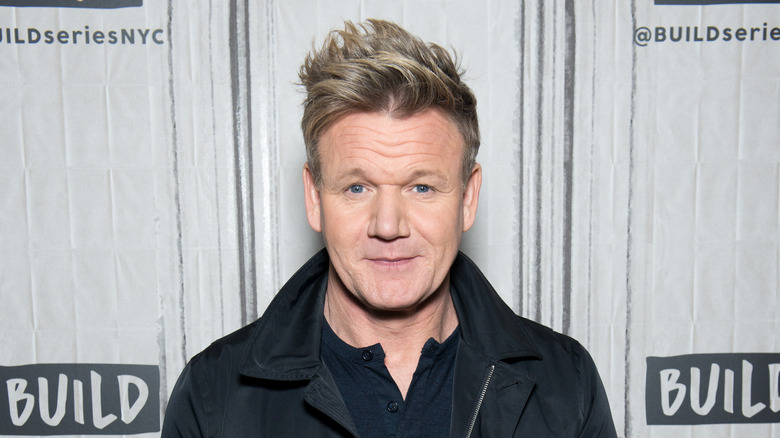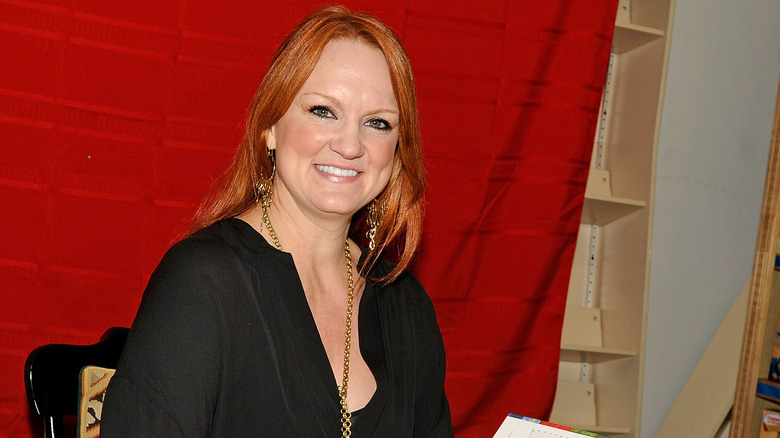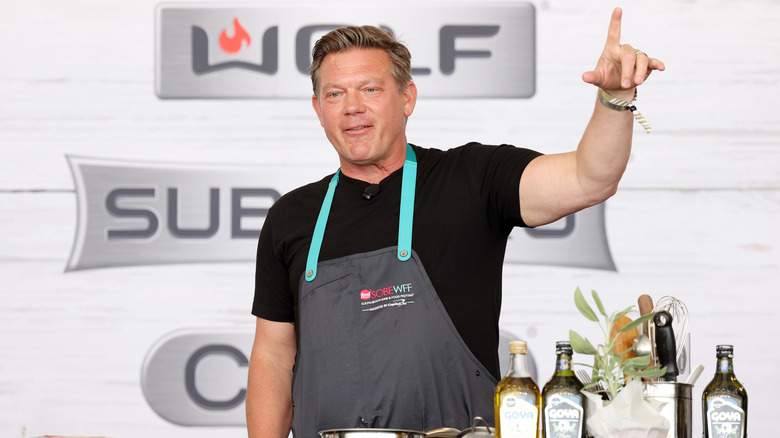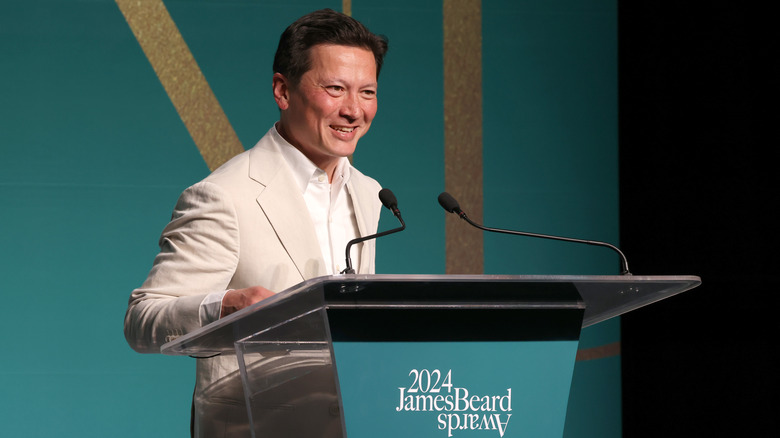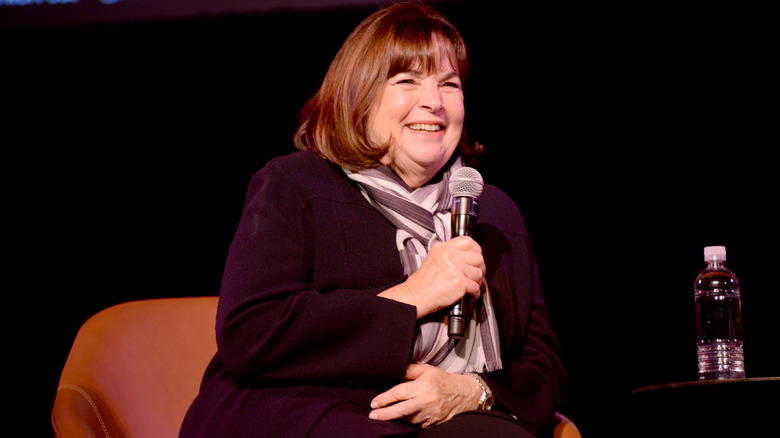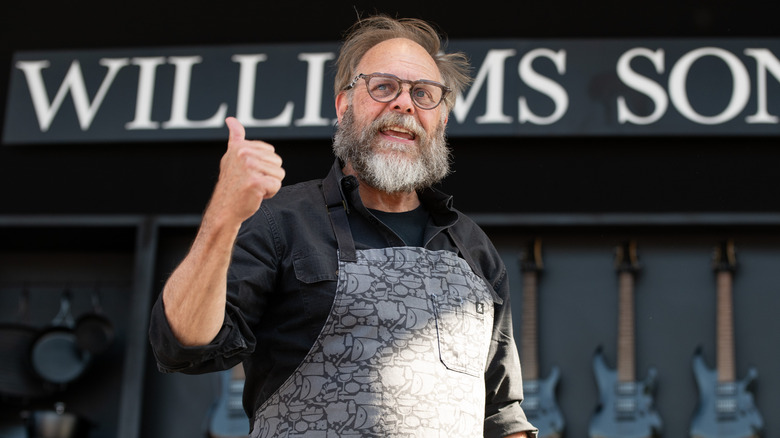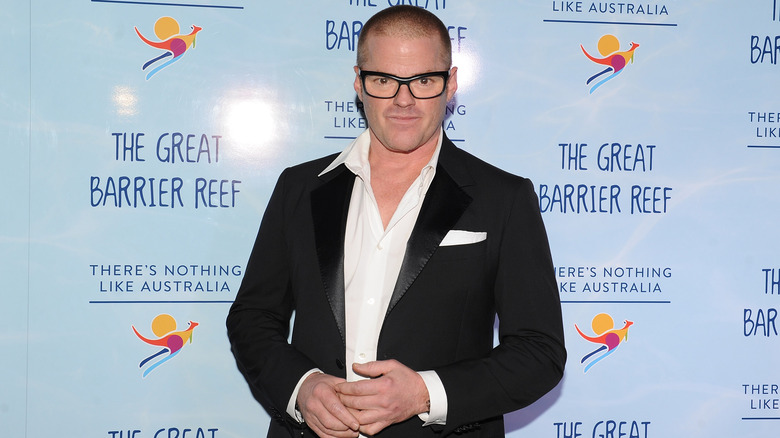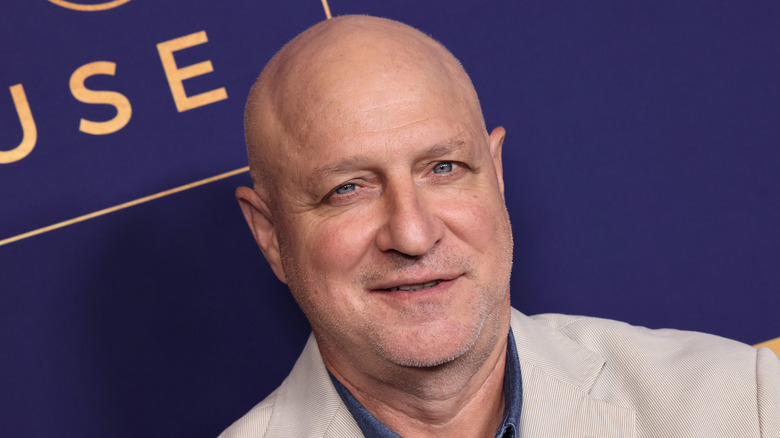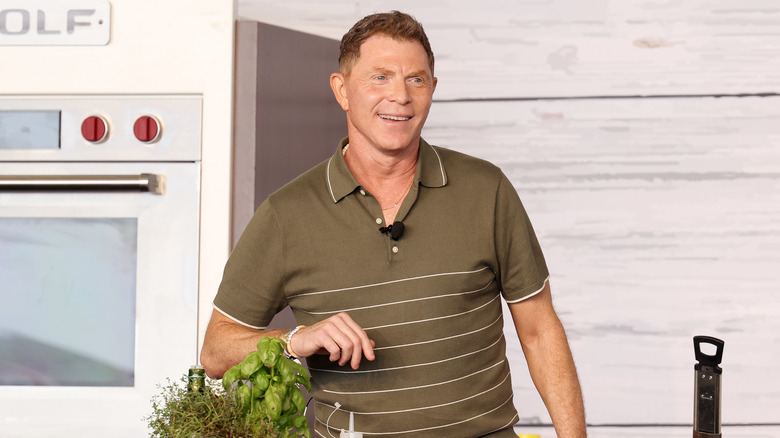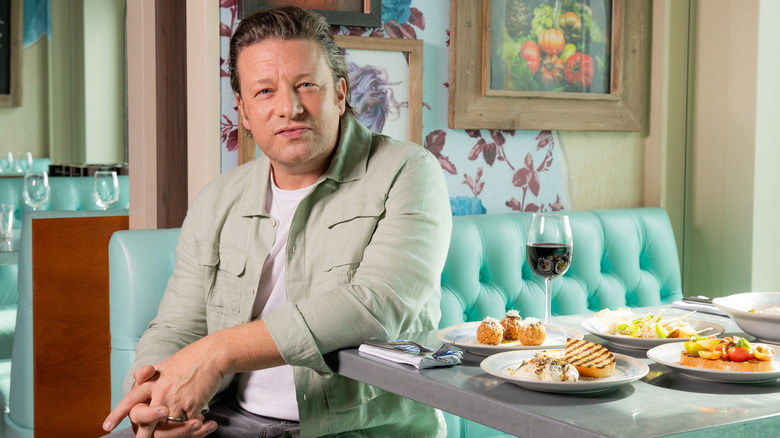13 Celebrity Chef Tips To Follow For The Best Scrambled Eggs
Scrambled eggs are such a simple dish, but they can be surprisingly hard to get just right. Cook them properly and they should be fluffy, buttery, and full of flavor. Cook them wrong and they can turn out grainy, rubbery, or just bland. So what are the secrets for making the best scrambled eggs? Well, that depends on who you ask. Every home cook and chef has different methods for achieving the fluffiest, tastiest scrambled eggs. For some pro tips, we decided to look to celebrity chefs to see what tricks they have up their sleeves.
Celebrity chefs may be able to hold their own in five-star kitchens and fast-paced cooking competitions, but what really sets the true culinary experts apart from the showboats is mastering humble everyday dishes. Scrambled eggs are about as humble as it gets, so we wanted to see how celeb chefs go about preparing this breakfast favorite. We came across some interesting star-approved methods for superb scrambled eggs, from proper stirring techniques to the best cooking temperatures and unique ingredient additions. These are some top celebrity chef tips that can help you take your scrambled eggs from sub-par to superior.
Jacques Pépin: Crack your eggs on a flat surface
Jacques Pépin began his culinary career in 1949 at the young age of 13. Since then, he's spent his entire career mastering classic French cooking techniques for elegant dishes like duck à l'orange, as well as simple meals like scrambled eggs. In fact, Pépin has an affinity for eggs. His first cookbook was titled "The Other Half Of The Egg" and was about how to cook eggs in a variety of ways. According to the chef, the first step for great scrambled eggs is properly cracking the shells.
On an episode of "American Masters: At Home with Jacques Pépin," the chef said you should always crack your eggs on a flat surface instead of something pointed. His main reasoning is that if the shell gets into the egg, it can introduce harmful bacteria. Plus, the jagged shells can break the yolk. The easiest way to crack your eggs like Pépin does is to give the egg a firm tap on a flat surface, then use your thumbs to gently separate the membrane from the shell. The egg should slide out easily into your bowl or pan.
Gordon Ramsay: Don't whisk the eggs before cooking
Gordon Ramsay may be best known for critiquing other people's culinary creations on television shows like "Kitchen Nightmares" and "MasterChef." However, the celebrity chef is also a wildly successful restaurateur and cookbook author who loves showing people how to create delicious dishes. Ramsay has given several demos about how to cook scrambled eggs where he offers helpful tips for getting the perfect texture and taste. One of Ramsay's top tips for flavorful scrambled eggs is to avoid whisking the eggs before pouring them into the pan.
In a YouTube video, Ramsay said, "We never whisk our eggs before we cook them. It turns the whole thing grainy." Instead, he suggests cracking the eggs directly into a cold pan. Set the pan on the heat, add a few knobs of butter, then use a rubber spatula to stir the eggs and break them up. Ramsay also recommends moving the eggs on and off the heat as you stir them and adding something cold like crème fraiche or sour cream at the end to prevent the eggs from overcooking.
Ree Drummond: Pass the eggs through a fine mesh strainer
Ree Drummond rose to fame for her food blog "The Pioneer Woman," and later her television cooking show of the same name for the Food Network. She's also authored several cookbooks. Over the years, Drummond has offered tons of unique tips for preparing eggs including dicing hard-boiled eggs with a cooling rack and using a zip-top bag to scramble and boil eggs for an omelet. When it comes to scrambled eggs, her secret weapon is a fine mesh strainer.
On an episode of "The Pioneer Woman," Drummond demonstrates how to make what she calls, "the best scrambled eggs ever." To start, she whisks the eggs and passes them through a strainer. The logic behind this is that the sieve removes pockets of air and ropey strands in the eggs, which results in smoother, silkier scrambled eggs. Drummond also adds half-and-half and black pepper to the eggs, then cooks them over low heat in a non-stick skillet. Her final touch is stirring in pieces of chopped smoked salmon and cooking the eggs until light and fluffy.
Tyler Florence: Throw an extra egg yolk into the mix
While some chefs like to add fancy ingredients to scrambled eggs like smoked salmon or truffles to amp up the flavor, Tyler Florence uses a simple ingredient to make his eggs ultra-rich and it's one you probably already have on hand. He told Popsugar that he always adds an extra yolk to his scrambled eggs and omelets because it makes the eggs "rich and very, very yellow." He explained that his ratio is usually one additional yolk to three full eggs.
Florence suggests adding the extra-yolky egg mixture into a pan with some butter and cooking it over very low heat. As you stir the mixture, the low heat will help the egg whites and protein to come together and thicken into a creamy consistency. The chef also likes to add a bit of dairy like sour cream to the eggs and serve them with just a sprinkling of salt. By following these tips, he said you should end up with "light-as-cloud, succulent, silky, beautiful eggs."
J. Kenji López-Alt: Add a cornstarch slurry to the eggs
J. Kenji López-Alt is no stranger to trying out innovative cooking techniques. His first cookbook, "The Food Lab," made waves for its unconventional cooking techniques that were backed by science. It should come as no surprise then that the chef adds a unique ingredient to his scrambled eggs that you may never have considered before. His secret ingredient is a slurry made of cornstarch and water. Being the self-proclaimed culinary nerd that he is, López-Alt has a solid evidence-based reason for using the slurry.
In a YouTube video, López-Alt explained that when eggs cook, the proteins bind together into a matrix. The more you cook the eggs, the tighter this matrix gets to the point that it starts squeezing out water. When that happens, the eggs start to get tough and rubbery. Adding a starch like cornstarch, potato starch, or tapioca starch can prevent this from happening because the starch blocks the proteins from binding together too tightly. In addition, any water that's released will mix with the starch and create a creamy texture.
Ina Garten: Avoid adding too much liquid to the eggs
You can always count on Ina Garten (aka The Barefoot Contessa) to offer great tips for classic comfort food dishes. Garten has shared several recipes for scrambled eggs over the years, including cacio e pepe scrambled eggs, truffled scrambled eggs, and a version with goat cheese. In a TikTok video Garten posted for her goat cheese scrambled eggs, she shared a valuable tip that she's learned for making beautifully textured scrambled eggs. Her secret? Go easy on the liquid.
Garten said, "If you put too much liquid into scrambled eggs, what happens is the liquid sort of oozes out. So, in fact, you use less liquid and they're lighter and fluffier." The type of liquid you add also matters. For example, adding milk to scrambled eggs is a texture risk because the milk causes the eggs to separate before they're done cooking. This can make your eggs rubbery and grainy. Milk also waters down the flavor. Instead of milk, Garten adds a splash of half-and-half for extra richness and creaminess.
Alton Brown: Whisk the eggs with some mayonnaise
Alton Brown is another chef who looks to science for inspiration on how to make his dishes better. If you've ever watched his Food Network show "Good Eats," you've probably seen him cook with some pretty interesting ingredients and cooking techniques. The extra ingredient Brown swears by for delicious scrambled eggs is a common condiment that's usually reserved for sandwiches. But Brown says that a dollop of mayonnaise can take your scrambled eggs to next-level creaminess.
As you might expect, Brown has received some flak from fans who think that mayo in scrambled eggs is just a bit too over-the-top. However, Brown defends his decision. On an episode of "The Late Night with Stephen Colbert," the chef explained that scrambled eggs are essentially an emulsion of fat and water just like mayonnaise. He said, "So mayonnaise is kind of like a booster to the emulsion that you're trying to make." Considering mayonnaise is also made with eggs, it stands to reason that the two ingredients would enhance each other.
Martha Stewart: Cook the eggs in clarified butter
Like many chefs, Martha Stewart uses butter in her scrambled eggs. The maven of home cooking doesn't use any old type of butter though. Her go-to for rich, creamy scrambled eggs is clarified butter. This versatile cooking fat is just butter with the milk solids removed. It has a much higher smoke point than regular butter, so it doesn't burn as easily. This means it's less likely to give your eggs a brown tinge and burnt flavor if you overcook them.
Clarified butter is easy to make at home. All you need to do is heat unsalted butter in a pot on the stove. You'll see the butter start to foam and bubble. Wait for the foam to sink to the bottom and the water to boil off. Once the bubbles start to subside, the water is probably done cooking out of the butter. At that point, you can strain the clarified butter to remove any leftover solids. You can use clarified butter just like you would regular butter in your scrambled eggs. Stewart recommends using about one tablespoon of clarified butter per egg. Simply cook the eggs in the butter, stirring constantly until light and fluffy.
Heston Blumenthal: Use a bain-marie instead of a pan
One of the biggest mistakes people make with scrambled eggs is overcooking the eggs. If you heat the eggs too quickly and for too long, they start to expel their moisture and can become rubbery and tough. Heston Blumenthal has a hack for that. He recommends cooking the scrambled eggs in a bowl over a bain-marie or a double boiler. The low heat from the steam in the bain-marie cooks the eggs slowly so that they don't dry out too quickly.
While demonstrating the bain-marie technique for scrambled eggs on an episode of MasterChef Australia, Blumenthal said, "You can of course whack it straight in a pan, whack the heat up, chuck the eggs in, chuck some butter in, season and serve it. But you don't get that same creamy texture." He explained that cooking the eggs slowly and gently over the water bath produces lovely curds with a light and luscious texture. This method requires time and patience, but according to the chef, it's well worth the wait.
Chrissy Tiegen: Go low and slow when cooking
Just like Heston Blumenthal, Chrissy Teigen is a fan of low and slow cooking when it comes to scrambled eggs. The star doesn't use any special equipment like a bain-marie to cook her eggs though. She simply uses a non-stick skillet. In an Instagram post, Teigen said she starts by whisking the eggs with cream, salt, and pepper and heating butter or olive oil on low heat in a skillet. She pours the eggs into the skillet and gently stirs and scrapes the eggs until they're thick and creamy.
According to Teigen, patience is the key to this method. She said, "The first 10 minutes won't look like much but then boom ... you'll notice it getting thicker and thicker ... Like cheesy eggs with no cheese!" All up, the eggs should take about 20 minutes to cook to a creamy, fluffy consistency. The star said she likes to serve her low and slow creamy eggs with bacon that's been roasted with garlic in the oven and cherry tomatoes tossed with olive oil and cooked in a hot pan.
Tom Colicchio: Constantly whisk the eggs as they cook
Many people add dairy products like half-and-half or crème fraiche to their scrambled eggs to give the dish creaminess. But that's not the only way to achieve that velvety texture. Tom Colicchio has a pro tip for getting extra creamy eggs without dairy. He told Business Insider that the best way to achieve scrambled eggs that are soft but cooked all the way through is to constantly whisk the eggs as they cook to introduce air into the mixture.
One way that Colicchio makes his creamy scrambled eggs is by pouring the eggs into a pan with butter and using a fork to constantly move them around in the pan. He said, "Too often people just turn the heat up and let it sit there. Once the pan is hot, if you just keep that high heat on there, it's going to burn everything." He recommended moving the eggs on and off the heat and using a spatula at the end to fold them over. Another method involves cooking the eggs in a pot and constantly whisking them until they start to cook. At that point, you can switch to a spatula to fold them until they're fluffy.
Bobby Flay: Hold off on adding salt until the very end
It's pretty hard to pigeonhole Bobby Flay to any one particular style of cooking. He's been known to excel at everything from Southwestern cuisine to steaks, seafood, and Mediterranean flavors. He's also been known to give cooking demonstrations for basic dishes like straightforward scrambled eggs. One of his tips for perfecting this easy-going breakfast dish is to leave the salt out of the mixture until the last step.
In a YouTube video where Flay demonstrated how to make scrambled eggs, the chef recommended whisking the eggs with pepper in the beginning but holding off on the salt until the very end. His reasoning was, "Sometimes salt can make them a touch grainy." Flay isn't the only person who believes this either. Gordon Ramsay also believes salt can break the eggs down too quickly and cause them to become watery. It should be noted though that there is a large camp of cooks who believe otherwise. Some say that salt prevents the proteins in the eggs from binding together too tightly, so you might actually get fluffier eggs. Others say it doesn't really make a difference either way.
Jamie Oliver: Take the eggs off the heat before they're done
One of the trickiest things about cooking scrambled eggs is knowing when to remove them from the heat. If you cook them too long, there's a good chance the eggs will turn out tough and flabby. According to Jamie Oliver, one way you can get around this is to take the eggs off the heat before they're actually done. Oliver said on his website, "Just remember that eggs are delicate and will continue to cook even after you've taken them off the heat, so it's really important to remove them just before they're ready so that they'll be just right by the time you come to eat them."
There's no hard and fast rule for exactly how long to cook your eggs to get the fluffiest, creamiest plate of eggs. However, there are a few key signs to look for that may indicate it's time to take your eggs off the burner. When the eggs start to develop curds, that's a good sign that the proteins are starting to coagulate. You may want to take them off when they're still a bit runny and let them sit in the pan for a minute or two to allow the residual heat to cook them all the way through.
